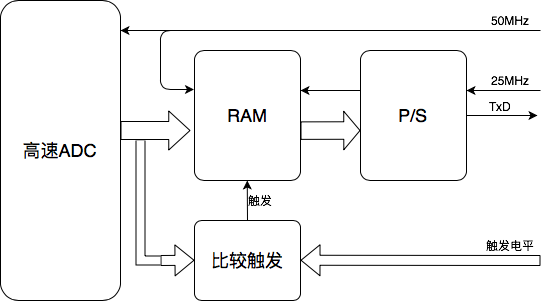**这是本文档旧的修订版!**
与示波器相关的Verilog代码

1 ADC采集
1.1 基于FIFO机制
FPGA处理2个时钟域之间的数据交换:
- 一个慢的系统时钟 - 固定为25MHz
- ADC采样时钟(一般为快速时钟,比如说50MHz),它由FPGA产生并送给ADC
从ADC采集到的数据以ADC的采样频率存储到FIFO中,FIFO的数据被另一个时钟读出,并通过并/串变换发往串口(比如115200波特率)或SPI总线驱动的LCD屏幕。
假如采用的FIFO的深度为1024个字节,50MHz的采样频率,花费大约20μS的时间将FIFO填满,一旦填满,我们就不再向FIFO发送数据,存储在FIFO中的数据需要使用低速的时钟全部读出并发送出去。如果采用115200波特率的串行通信方式,大约每秒可以传送10KBytes,1024个采样点数据需要大约100ms全部发送完毕,在此期间,示波器是“盲”的,因为其采集到的数据都会被丢弃掉,不会存储到FIFO中,也就是说有99.99%的时间是“盲”的,采用这种架构带来的这种结果是非常正常的。
如果添加了“触发”的功能,则可以靠触发条件来选择数据。
ADC输出的数据总线通过8个管脚连接到FPGA,我们命名这8位的数据为“data_adc[7:0]”, 速率很高, 最好先用寄存器来同步一下:
reg [7:0] data_adc_reg; always @(posedge clk_adc) data_adc_reg <= data_adc;
FIFO为1024个word的深度 * 8bit的宽度,50Msps的采样率,需要花费大约20μs填满FIFO。FIFO可以用FPGA内部的同步SRAM来构成,不同FPGA厂商的IP构成方式不同,但功能都是一样的。
完成了FIFO的例化以后,我们就可以通过FIFO将数据连接起来:
fifo myfifo(.data(data_adc_reg), .wrreq(wrreq), .wrclk(clk_adc), .wrfull(wrfull), .wrempty(wrempty), .q(q_fifo), .rdreq(rdreq), .rdclk(clk), .rdempty(rdempty));
向FIFO中写数据 为向FIFO中写数据,我们需要等待到空的状态,一旦FIFO的状态变“满”,则停止写数据,代码逻辑如下:
reg fillfifo; always @(posedge clk_adc) if(~fillfifo) fillfifo <= wrempty; // start when empty else fillfifo <= ~wrfull; // stop when full assign wrreq = fillfifo;
从FIFO中读取数据 只要FIFO不空,就可以从中读取数据,读出的每一个字节发送到串行输出模块
wire TxD_start = ~TxD_busy & ~rdempty; assign rdreq = TxD_start; async_transmitter async_txd(.clk(clk), .TxD(TxD), .TxD_start(TxD_start), .TxD_busy(TxD_busy), .TxD_data(q_fifo));
然后我们就可以通过调用“异步发送”的功能模块将数据编程变成串行,并通过“TxD”信号管脚发送出去。
完整的设计:
module oscillo(clk, TxD, clk_adc, data_adc); input clk; output TxD; input clk_adc; input [7:0] data_adc; reg [7:0] data_adc_reg; always @(posedge clk_adc) data_adc_reg <= data_adc; wire [7:0] q_fifo; fifo myfifo(.data(data_adc_reg), .wrreq(wrreq), .wrclk(clk_adc), .wrfull(wrfull), .wrempty(wrempty), .q(q_fifo), .rdreq(rdreq), .rdclk(clk), .rdempty(rdempty)); // The ADC side starts filling the fifo only when it is completely empty, // and stops when it is full, and then waits until it is completely empty again reg fillfifo; always @(posedge clk_adc) if(~fillfifo) fillfifo <= wrempty; // start when empty else fillfifo <= ~wrfull; // stop when full assign wrreq = fillfifo; // the manager side sends when the fifo is not empty wire TxD_busy; wire TxD_start = ~TxD_busy & ~rdempty; assign rdreq = TxD_start; async_transmitter async_txd(.clk(clk), .TxD(TxD), .TxD_start(TxD_start), .TxD_busy(TxD_busy), .TxD_data(q_fifo)); endmodule
1.2 双口RAM的方式
先说一下“触发”
完整的设计
module oscillo(clk, RxD, TxD, clk_adc, data_adc); input clk; input RxD; output TxD; input clk_flash; input [7:0] data_adc; /////////////////////////////////////////////////////////////////// wire [7:0] RxD_data; async_receiver async_rxd(.clk(clk), .RxD(RxD), .RxD_data_ready(RxD_data_ready), .RxD_data(RxD_data)); reg startAcquisition; wire AcquisitionStarted; always @(posedge clk) if(~startAcquisition) startAcquisition <= RxD_data_ready; else if(AcquisitionStarted) startAcquisition <= 0; reg startAcquisition1; always @(posedge clk_adc) startAcquisition1 <= startAcquisition ; reg startAcquisition2; always @(posedge clk_adc) startAcquisition2 <= startAcquisition1; reg Acquiring; always @(posedge clk_adc) if(~Acquiring) Acquiring <= startAcquisition2; else if(&wraddress) Acquiring <= 0; reg [8:0] wraddress; always @(posedge clk_adc) if(Acquiring) wraddress <= wraddress + 1; reg Acquiring1; always @(posedge clk) Acquiring1 <= Acquiring; reg Acquiring2; always @(posedge clk) Acquiring2 <= Acquiring1; assign AcquisitionStarted = Acquiring2; reg [8:0] rdaddress; reg Sending; wire TxD_busy; always @(posedge clk) if(~Sending) Sending <= AcquisitionStarted; else if(~TxD_busy) begin rdaddress <= rdaddress + 1; if(&rdaddress) Sending <= 0; end wire TxD_start = ~TxD_busy & Sending; wire rden = TxD_start; wire [7:0] ram_output; async_transmitter async_txd(.clk(clk), .TxD(TxD), .TxD_start(TxD_start), .TxD_busy(TxD_busy), .TxD_data(ram_output)); /////////////////////////////////////////////////////////////////// reg [7:0] data_adc_reg; always @(posedge clk_adc) data_adc_reg <= data_adc; ram512 ram_adc( .data(data_adc_reg), .wraddress(wraddress), .wren(Acquiring), .wrclock(clk_adc), .q(ram_output), .rdaddress(rdaddress), .rden(rden), .rdclock(clk) ); endmodule
1.3 触发
检测一个上升沿
reg Threshold1, Threshold2; always @(posedge clk_adc) Threshold1 <= (data_adc_reg>=8'h80); always @(posedge clk_adc) Threshold2 <= Threshold1; assign Trigger = Threshold1 & ~Threshold2; // if positive edge, trigger!